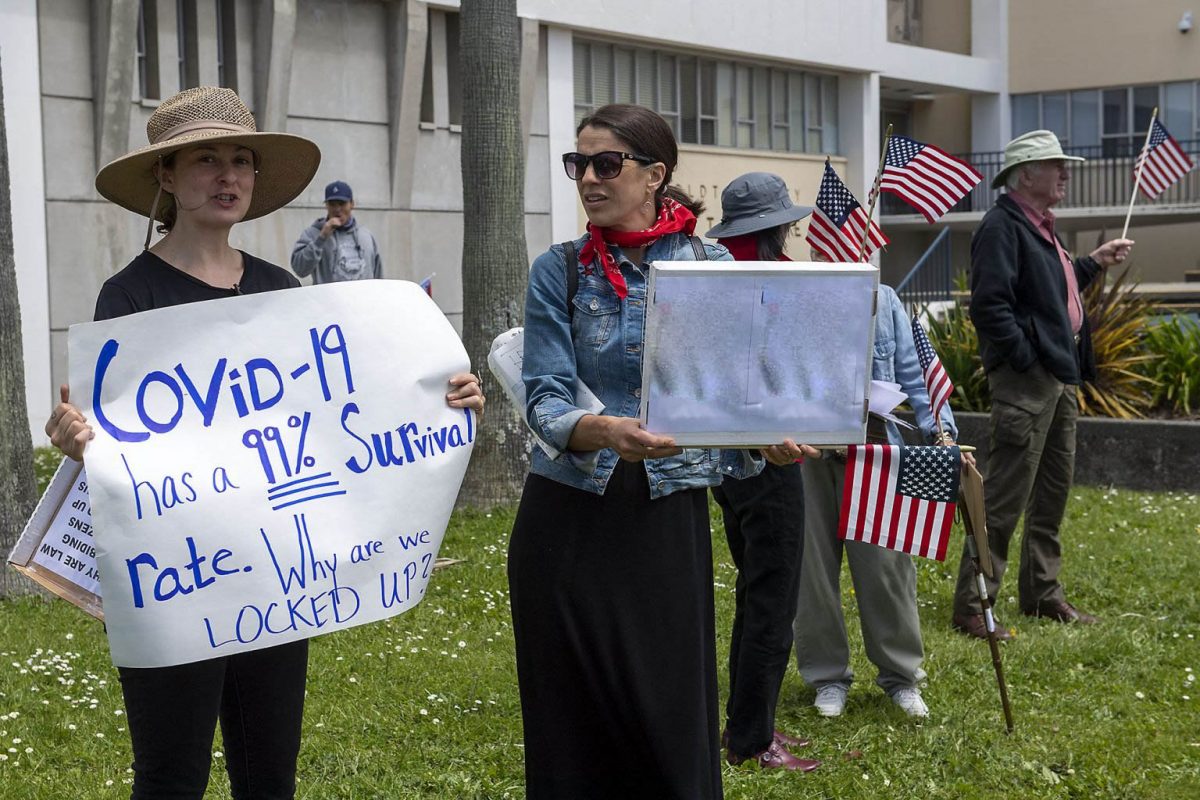Fascism thrives on chaos, inserting itself into emerging fissures and faults. Not unlike a virus. There are plenty of people doing fascism right now in visual media. And during the pandemic, the social is media. What are the antifascist tactics to disrupt the online fascist wave? No reposting. Whiting out white supremacy. Undermining its claims. And imagining the future.
There’s no way to engage with fascism that has no risk. These are tactics. If they don’t work, then let’s drop them and find better ones. If they do, make them more effective. I’m just not happy seeing swastikas and racist imagery all over my social media.
Fascism is using public space to display its double accusation that stay-at-home policies are Nazism, whose implementation is communism. These small-scale actions have made for a chaos of meaning that has enabled the mass online circulation of everything from Confederate flags to armed takeovers of legislatures and Nazi imagery.
- Don’t repost to show how horrified you are.
At a typical “protest” at Commack NY (in Suffolk County with over 40,000 COVID-19 cases and more than 1700 deaths), a small group of reopeners insulted and harassed a local TV news reporter Kevin Vessey. He posted a video to Twitter. Trump then reposted it–twice–with each post getting over 100,000 retweets. If you don’t think that matters, ask Hillary Clinton how she’s enjoyed the last four years.
Beyond the tactical, these images do harm by themselves. During the 2014-16 moment of Black Lives Matter, African American activists reached a point where they no longer wanted pictures of violence distributed. I’ve reached that point with the fascist protests in the US today. It’s just not necessary to see every swastika. It doesn’t help with analysis or resistance and it maintains the sense of chaos that the far-right want to engender.
2. White Out
I’m not advocating just ignoring the violent image. I want to disrupt the chaotic effect they’re intended to cause. Take that appalling image of a white woman standing outside a courthouse in Humboldt County CA, holding a sign that depicted an enslaved African wearing a metal muzzle across the mouth, and an iron collar with a spike. The text was just as bad: “Muzzles are for dogs and slaves. I am a free human being.”
I don’t want to post that picture unchanged. As a teacher, I’ve long realized that simply showing a racist image does immediate harm. Under the currently existing conditions of white supremacy, the image is downloaded and absorbed at once. To say nothing of the pain it causes. Setting an alternative context, teaching the history, making it look otherwise–that takes time and care.
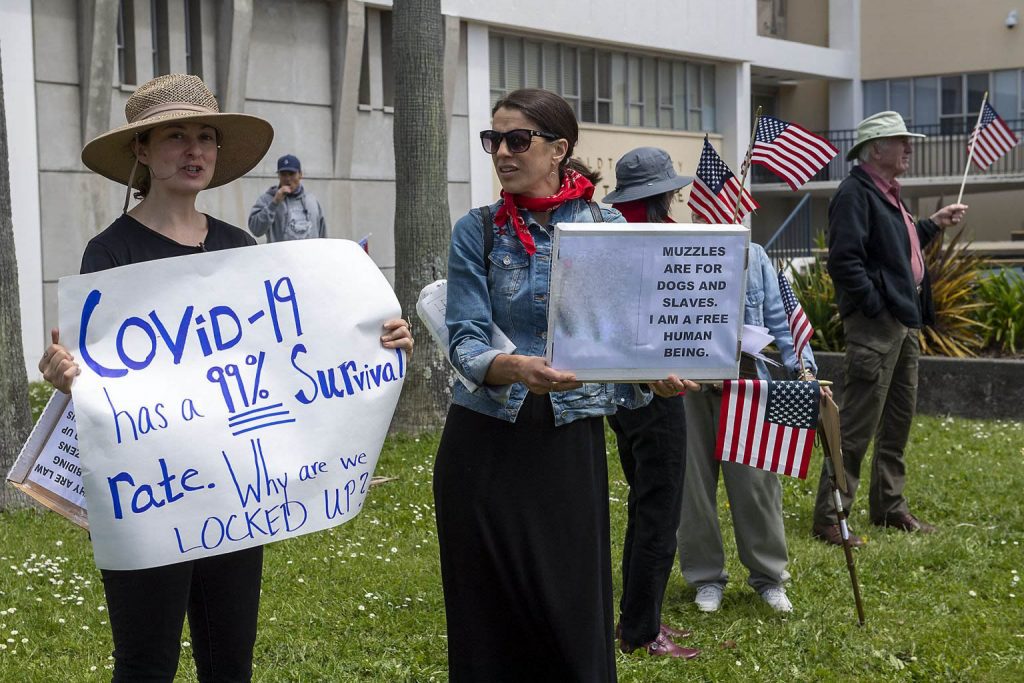
My simple tactic is to “white out” that image. Whiting out white supremacy. It’s affiliated with other such tactics, like the practice of redaction advocated so beautifully by Christina Sharpe. I’m also thinking of the erasure of lynched African Americans from the photographs in Claudia Rankine’s Citizen, as did Ken Gonzales-Day and Mary Coffey.
The last show I saw before everything shut down was the outstanding recent series of photographs by Nona Faustine entitled “My Country,” which feature a bar across American monuments. I am not equal to these distinguished sources, I am aware. This is simply a step to think through how a challenge to visual images claiming white supremacy might be made visually by a person identified as white
I also used all the photograph posted by Kym Kemp (May 16, 2020). You can see that the different protestors made different choices. To the left, a woman chose to use her own sign, not the printed ones handed out. To the right, the drama teacher who features in all the cropped images has folded up her sign and taken the home-made but printed sign. She now claims she was just holding it after somebody else gave it to her but falsely asserts: “I had no sign of my own.” Yes, you did, you just folded it up. It’s almost impossible to notice that when confronted with the violent image.
The point is to be able to create a context in which to see what’s happening and then, if others agree, introduce the context and show the content. But there’s no point in worrying about how the fascists will respond: we know how they will respond.
Should the text be whited out too? Then you get this:
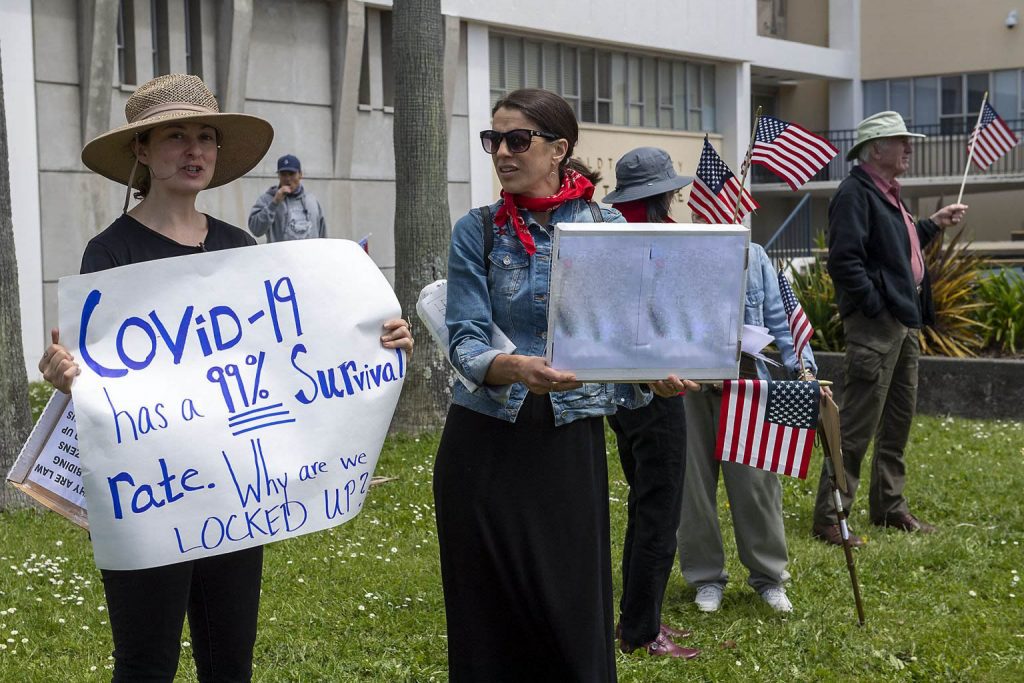
It’s a little more surreal. It invites a caption. The original text reveals that white supremacy continues to believe that the enslaved were not human beings, any more than dogs. It rests on the polygenist “theory” that there are multiple species of humans with different capacities. Such ideas circulated widely in the 1850s and ’60s as a defense of slavery. Without the startling image, this nonsense can literally be seen for what it is.
In a classroom, I would work back from the fully whited-out sign to the text and then take a vote as to whether the image should be shown. Then the picture could be introduced as an illustration to the Memoirs of a Blind Man by Jacques Arago (1839), written when the author was in fact blind so could not check the image for accuracy. Then the history of Escrava Anastasia, the woman depicted, who was resistance leader among the Brazilian enslaved, could be shared. Only then would I show the engraving.
3. Undermining
One thing fascists hate is to be made to look ridiculous or to have their claims to power undermined. Montage works wonders at ridiculing the pompous. Most of us can’t be John Heartfield. But deploying memory and simple tools, you can make mash-ups that mock the would-be saviors.
In my example, Mike Pence is visiting the Mayo Clinic. As it’s a medical facility, everyone is wearing masks but not Pence. He’s too powerful to get infected, too masculine for a girly mask, and too divine to need its protection. Photographer Jim Mone depicted him in a gesture of apparent benediction or healing. Most of Mone’s shoot was generic but this photo evoked to me a painting from an older epidemic.
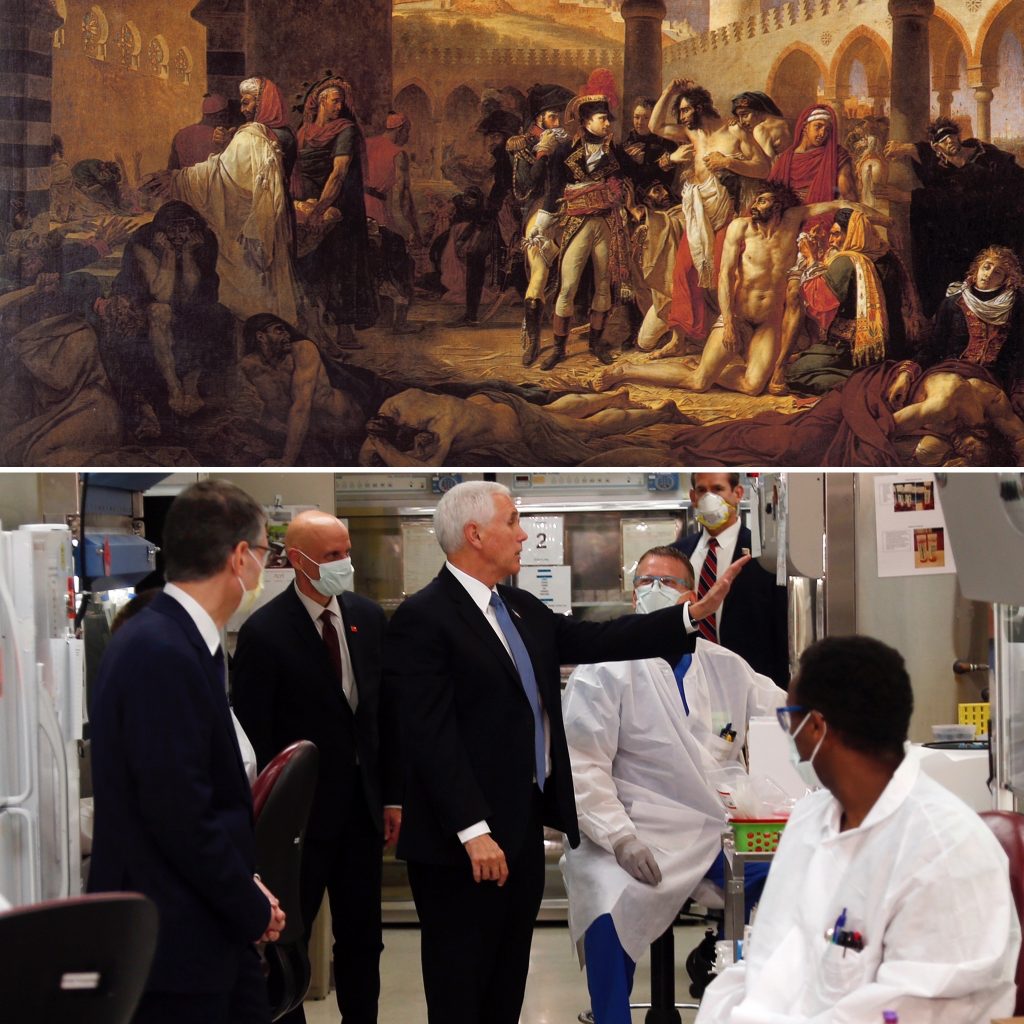
Baron Gros’ immense oil painting showed Napoleon in a plague house in Jaffa, Palestine. While his officer covers his face to ward off infection, Napoleon reaches out to touch an infected man. The gesture echoed that of the French kings, who would use their touch to heal scrofula, a form of tuberculosis.
It’s good to be a king, in the administration’s mind. But they’re not supposed to make it so clear in what remains nominally a republic. Bonapartism is notorious for appearing first as tragedy, the second time as farce. Pence is a farce and the montage makes that apparent even if you don’t know what the painting is.
Too complicated? Try this. In Texas, some businesses are reopened but not bars. A bar in Odessa TX reopened with some gun-carrying men claiming to “protect” it. When the New York Times ran the story, it led with a photo of a wanna-be tough guy with a tattoo, a bandanna and an AR-15. All the usual “we’re willing to die” rhetoric. This is what actually happened.
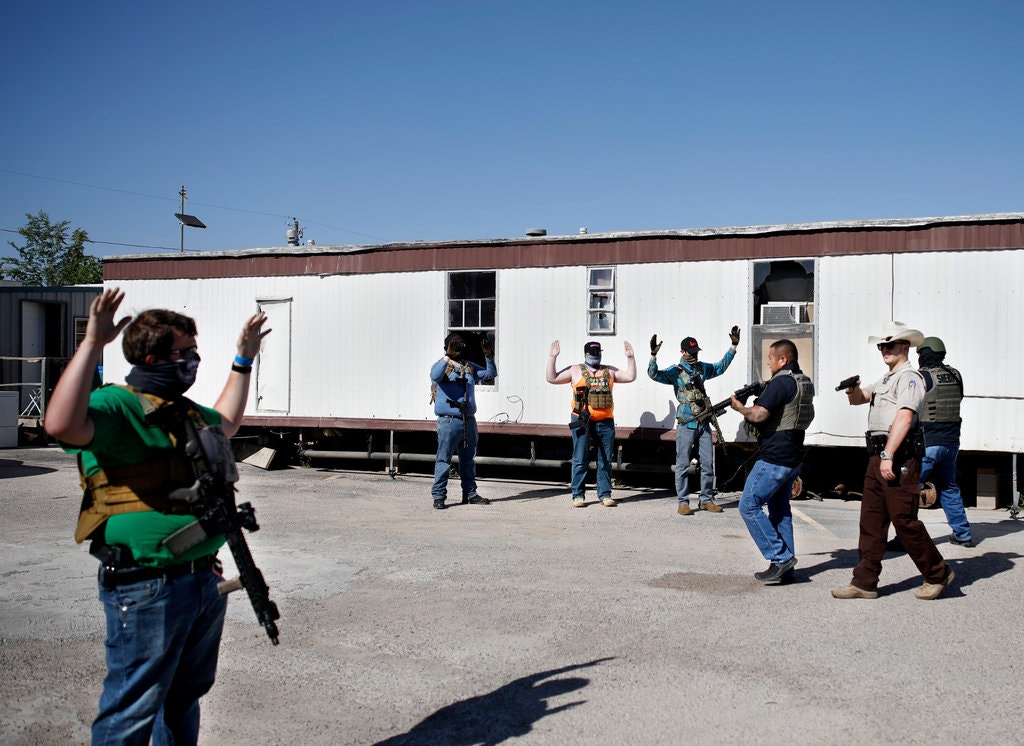
The original story in the Odessa Advertiser made it clear that this was all an effort to profit and get publicity. No one, in deep Texas, was trying to take their guns. But for all bluster, these liberators were all hat and no cattle.
4. Reclaim The Future
The swastika, MAGA crowd are all about the past. Going back has become code for “go back to militarized white supremacy.” Last time this crowd showed themselves openly at Charlottesville, they were comprehensively defeated but it came at a heavy price: the murder of Heather Heyer. That’s why there are Confederate flags at all the Astroturf protests. They know it’s the second round. They’ll lose again but the cost of human life may be much greater.
That’s why it’s also important to reclaim the future. Mutual aid has been a key part of getting through this first wave, as Rebecca Solnit has chronicled. Since the emergence of the Zapatistas in 1994, an alternative agenda has been clear, including respect for the Indigenous; direct democracy; sustainable economies for human and other-than-human life; health care and other forms of care as the key around which to organize society; production for need not profit; and an end to violence.
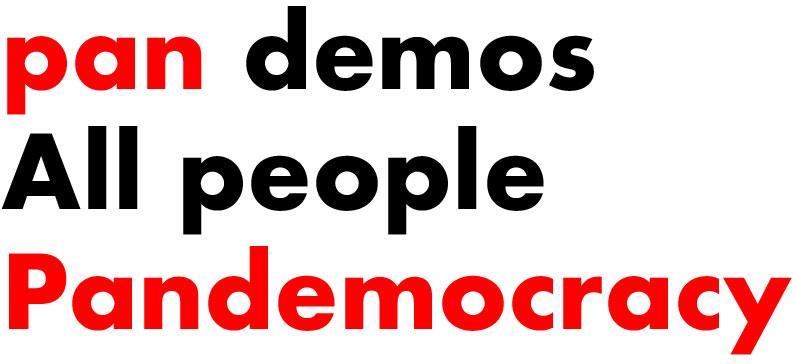
The pandemic highlights in bold why we need all this as matters of life and death. Who are we? Pan demos. All the people. The future is pandemocracy. All colonial thought and practice imagines democracy–opposed to the republic–as pandemonium, literally the presence of all demons, and figuratively as a cacophony in which no sense can be made. For the pandemocracy, learning to speak, to connect the visible and the sayable, articulating “that-which-must-be-made-sense-of” (Pasolini) is the work that is collectively at hand.
